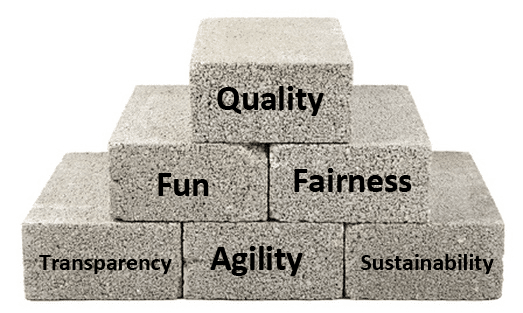Ask a strategic consultant about the value of a strong organizational culture and she’ll likely remark: “Culture eats strategy for lunch!” Her reasoning is usually based on the consistency of behavior that strong culture creates – enabling every associate to make “the right decision” even when the leader is not around. The name of the game in business growth is scalability, growing steadily without sacrificing consistency in quality (whatever that means to you.)
Org-culture is a conversation, led by leaders, about “how we do things here successfully.” It’s built up through hiring, on boarding and successions practices. It’s reinforced through rituals and stories, often shared at the group level. The more leaders punctuate the conversation with action, the more the followers march in lock step with them.
But here’s the problem: Every idea is based on an assumption, and similarly, every culture is based on a set of values. When transparency is a key value, the culture requires sharing information and avoiding secrecy. When someone violates it, they are shunned, punished or coached. The word ‘transparency’ is often embedded into internal communications and in some cases, the market facing branding. While few would argue against transparency, I would take issue with whether that value is a leader’s personal value or a business driver.
The purpose of an organization is to produce customer/member value, which in turn is captured in order to sustain and grow it. If culture drives consistency, then it should be based on values that drive the business by producing a unique value proposition. In other words, your culture-driving values should differentiate a company in a way your customers care about. That’s the real reason that culture has become a focal point of leadership development and corporate performance.
When Zappos put a supreme value on “Delivering Customer Happiness,” it separated them from other apparel e-commerce providers. They redesigned call center rules, adopting unconventional KPI’s to ensure that reps spend ample time with customers and display empathy and a sense of humor. They enforced the culture heavily throughout hiring an on boarding, famously offering briefcases of money to those who were willing to quit (and leave the Happiness Culture). In this case, the value drove the business.
But in too many cases, values are often created in a cramped conference room by over-worked founders or later in the life of the enterprise, by corporate communications during a turnaround. There is little or no formal training on how to vet a value for business output, it’s usually just a random process where words or phrases are thrown around until the group forms a consensus.
That’s why companies have chosen “Fun” or “Fair” or “Agile” as their values – making them the foundation of the culture they are building. And it’s hard to debate the value of fun, fairness or agility from a personal or even professional standpoint. Why not? That’s why they are often adopted. But what if the company is in the financial services market, where “Meticulous” is valued by the customer more than “Fun”? What if the company is in a risk-averse business, where customers value “Best-To-Market” instead of “First-To-Market”? In those cases, Fun and Agility are not business drivers, they are pet values, which are likely to build more of a cult than a strong corporate culture.
So here’s the prescription: Test the values that you base your culture on for business value. If you choose “Honesty” for example, ask yourself, “is this a market space where deceit is a customer concern? Is this a lead story in our industry?” If it is, then this value will drive the business through differentiation. If not, then you are basing your culture on a foundation that could lead to a me-too market position. If your competitors are honest, then why is this a business driver value and not just “good business practice”?
You might be thinking, “What’s the harm in including obviously good values in our culture mix? Why exclude “Fun” or “Honesty”? I thought that way too for a long time, but when I went to work in human resources, where values are a part of the talent lifecycle, I realized that you have to pick your battles, and limit yourself to a manageable group of norms you want to create.
Limit yourself to 3-5 values, the less the better. Much like phone numbers or login passwords, the longer the list, the harder it is to call up when you need them. Culture is all about living a set of values everyday, and if you throw in the kitchen sink, your associates will have to pick and choose, and that’s where a culture starts to get weak (read: inconsistent).
It’s never too late to go through the business driver value process with your team. If it leads to a new conversation about “how we do things around here moving forward,” it just may help your company jump out of the pile, and rise to the top of the customer’s mind. Just like a company can outgrow its founders, an organization can also outgrow its founding values.
Note: The recent holocracy movement at Zappos is based on the founder’s value of self-management. It’s yet to be seen as to whether that’s a pet value or a business driver (their relative customer experience levels will be lifted). In the long run, the fate of the company’s market position will be an acid test of my theory about picking personal or business centric values to base a culture on.
Watch: Culture Is A Conversation by Tim Sanders


